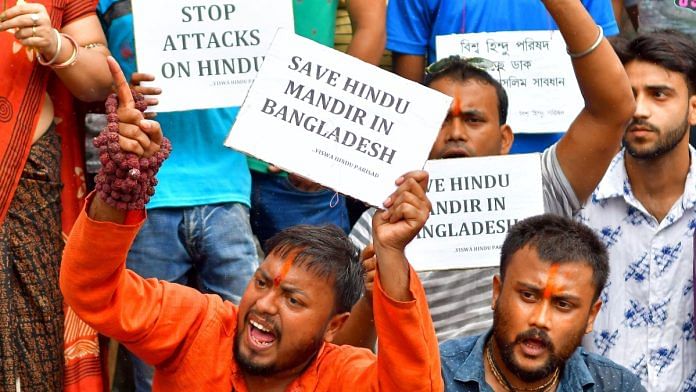This week, many Hindi news channels may feel vindicated: authorities in Dhaka finally admitted what many of them had been claiming for a while: Hindus in Bangladesh have faced communal attacks.
On Wednesday, leading English newspaper The Times of India gave the news front page importance: ‘B’desh admits 88 violent attacks on minorities’, read its headline. Its online version was more explicit: ‘Bangladesh say 88 cases of violence recorded against minorities, primarily Hindus since Hasina’s ouster.”
Since the Sheikh Hasina government fell on 5 August—and even on 9 December when India’s Foreign Secretary was in Dhaka for the first high-level official visit between the two countries since then—many Indian news outlets have highlighted alleged attacks on Hindus, on their property and their temples in Bangladesh. For instance, two days before Foreign Secretary Vikram Misri left for Dhaka, many Indian news media reported the alleged burning down of a temple in the Bangladeshi capital. A news agency story was widely published by many newspapers.
What developed into a tu tu main main between the news media of the two countries saw Bangladesh’s media hitting back with vehement denials and accusations of misinformation by certain Indian news outlets. This Daily Star article is an example: ‘Politics of Indian Propaganda Regarding Bangladesh’
So, when Shafiqul Alam, press secretary to the Bangladeshi interim government led by Muhammad Yunus, admitted to 88 instances of communal violence “a day after the foreign secretary Vikram Misri flagged attacks on minorities” (Times of India), it confirmed many of the news stories.
Defending Hindus
What was surprising is that on the day Misri visited Dhaka to reopen communication channels between the two governments, Hindi news channels such as India TV went sensational on Bangladesh’s ‘war on India’. “Bangladesh is openly anti-Indian,” said an India TV report. These stories were in response to a video of Bangladesh Nationalist Party’s (BNP) Senior Joint Secretary General Ruhul Kabir Rizvi’s comment on 8 December that if India lays claim to Chittagong, it would have to return Bengal, Bihar, and Odisha to Bangladesh.
India News claimed ‘Yunus to Invade India’. One of its anchors asked, “What is Yunus thinking?” He went on about the Bangladesh interim government being a part of Pakistan’s “toolkit”, “a puppet” of Islamabad.
Another Hindi channel said that Bangladesh had turned to Pakistan for potatoes and onions—it was already importing sugar from there. ‘Bangadesh-Pak will eat potatoes and onions’ read the headline.
Channels such as Times Now Navbharat took up arms in defence of Hindus in Bangladesh: ‘Injustice to Hindus—in Bangladesh a war of religion—temples are burning in Bangladesh’. A temple burning story was telecast by many TV news channels and in newspapers.
However, at least one newspaper, The Times of India, was confused about the identity of the temple: Was it the ISCKON centre in Dhaka, the Mahabhagya Lakshminarayan Mandir or a family temple of an ISCKON devotee?
The indignation on behalf of Hindus in Bangladesh became shriller as channels replayed Uttar Pradesh Chief Minister Yogi Adityanath’s remarks last week on ‘Babur, Bangladesh and Sambhal: all share similar DNA’.
Also read: Guess who got US election results right? Thailand’s Moo Deng
Internal affairs, bilateral ties & headlines
Much of the Indian and Bangladeshi news media may well simply be reflecting what The Indian Express called the “strain in bilateral ties…” (10 December). However, Shafiqul’s admission was reported by several leading newspapers in both countries in similar ways to suit their respective audiences. While the Dhaka Tribune wrote, ‘Shafiqul: 70 arrested in communal violence in August-Oct’, in India, Business Standard wrote ‘Bangladesh confirms 88 attacks on minorities, primarily targeting Hindus’.
Reporting on the meeting between Misri and his Bangladeshi counterpart Mohammad Jashim Uddin saw a degree of calmness. Newspapers such as The Indian Express, Hindustan Times, and The Hindu published page 1 lead stories on 11 December that emphasised India’s ‘minority’ problem with Bangladesh. ‘Misri visits Dhaka, airs concerns over safe of minorities’, wrote The Hindu, while The Indian Express went for a more balanced approach: ‘Foreign Secys meet: Delhi flags plight of minorities, Dhaka says internal issue.’
Across the eastern border, The Daily Star inverted the headline: ‘Dhaka asks New Delhi not to interfere in its internal affairs’. The Daily Observer (10 December) also did a balancing act. A page 1 story led with a report from the Bangladesh viewpoint—‘Dhaka urges Delhi to refrain from interfering in internal affairs’, while the adjoining report stated—‘Indian FS highlights people-centric ties amid minority concerns’.
Editorials on both sides of the fencing along the border made some conciliatory noises: ‘In Two to Tango’, The Hindu (11 December) wrote, “Given the largely positive optics of the visit, it would appear that there is an attempt to charge a new course in ties…”
“It is only positive that… the formal diplomatic channel has once again opened up for regular consultation and official dialogue,” stated Daily Observer (10 December) in its edit, ‘BD-Indian Foreign Secretaries meet amidst tense times’.
The author tweets @shailajabajpai. Views are personal.
(Edited by Ratan Priya)







Be honest, don’t be puppet of anti nationals. Being honest and fair will give you peace of mind. You call yourself a journalist…. So you think whatever your own thoughts you write will have effect on readers… they will follow you.. Filling minds with doubts and confusing people is not journalism. You very smartly write your own thoughts in such a way that looks like you are asking or raising questions, it completely looks like you are confused but in reality you are sowing such seeds that will multiply in many confused people. But those confused people’s number will be so negligible that they will not any effect on Bharat.
You are wrong.